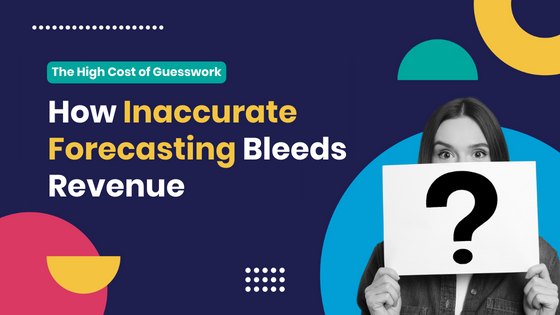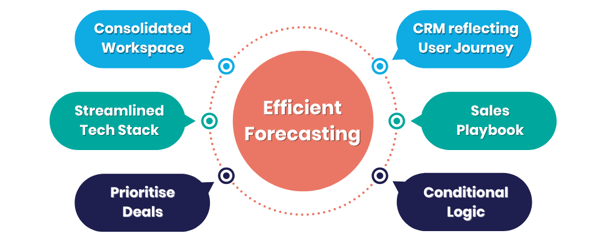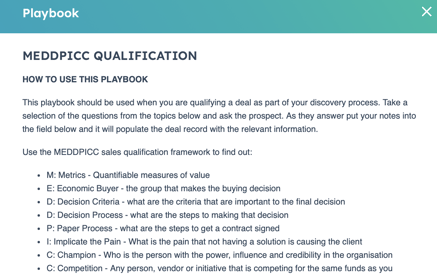






Look, we get it. Forecasting isn't exactly a walk in the park.
One wrong turn and you're lost. You're losing valuable revenue.
According to LinkedIn, messing up demand forecasting can cost you real dollars. Too much inventory? That's money down the drain. Too little? Say hello to missed sales.
Costs of Inaccurate Forecasting: Direct and Indirect
A recent Forrester report highlighted the direct and indirect costs of inaccurate forecasting.
Operationally, it leads to capacity planning failure, increased carry cost for inventory, and tightening of budget and resources. It also erodes trust in corporate and sales leadership and has broader business implications, such as less ability to invest in growth, negative impact on market valuation, and less ability to attract capital investment.
The primary culprit behind this chaos? Poor data quality.
Without accurate information that reflects real-time changes, your forecasting efforts are about as reliable as a weather prediction without a barometer.
Lack of quality data points, shadow sales tech, and increasing complexity and volatility (like complexity in buyer journey and new revenue models) make it difficult to forecast accurately.
The Catch-22 of Manual vs. Automated Forecasting
Manual forecasting, with its endless spreadsheets and human error, is an approach we recommend avoiding, if possible.
But before you jump ship to automated forecasting, remember that even the most sophisticated system is only as good as the data it's fed. If your data is lacking, inaccurate, or outdated, you're still heading for troubled waters.
And the challenges don't stop there. What if your sales reps lack crucial information about deals? Or they're too swamped (or forgetful) to update the CRM? Or perhaps they're overestimating or underestimating their sales forecasts?
Forecasting strategies are built around the people, not just the processes
Fixing forecasting is not just about implementing new processes - it's also about considering the people who will carry out these processes. New methods can often be seen as additional work by reps if they don't understand the value, leading to more admin work and less selling time.
So, what's the antidote to this problem? It lies in designing your tech, processes, and data systems with your people at the heart of it all.

1. Simple, consolidated workspaces
Consider creating a consolidated workspace that makes updating records as simple as clicking a button. This not only reduces the time spent on data entry but also minimises the potential for errors.
2. A CRM that reflects your customer journey
A CRM should be more than just a data repository; it should be a reflection of your customer journey. This way, your team can get a comprehensive view of each customer, understand their needs better, and tailor their approach accordingly.
3. Streamlining your sales tech stack
Reflect on this - is your team inputting data into multiple systems? Can they gather a holistic picture of the customer lifecycle within a single system? If the answer is 'no', there's a possibility that your sales process could be overcomplicated. Consider consolidating your sales tech stack to streamline data management and enhance efficiency.
4. Implementing a sales playbook
Introduce a sales playbook that outlines the data correlating with higher win rates. Ensure that your processes are built to consistently collect this data. This provides your representatives with a clear roadmap, reducing ambiguity and boosting their confidence.
5. Prioritising deals
Every person has limited resources - as much as we might like to make a million calls, emails and demos, we only have so much time.
So, how do you go about supporting your reps in converting high-quality leads?
Well, your reps must know which deals to prioritise.
6. Incorporating conditional logic
Conditional logic can serve as a potent tool in sales processes. It allows you to create dynamic processes that adapt based on the data entered. For example, if a deal reaches a certain stage, specific tasks could be automatically assigned to the representative. This can streamline workflows and ensure that no step is overlooked.
Quantitative sales forecasting & cooperative processes
Alongside these strategies, consider employing quantitative sales forecasting methods. These can assist in gauging the probability of a deal reaching the "Closed Won" stage at each phase of the sales process. A shared forecasting process, involving coordination and collaboration across teams, can also enhance accuracy and consistency.
The Value Proposition of Time Spent on Forecasting
According to HubSpot, the average salesperson dedicates approximately 2.5 hours each week to this activity. This amounts to an astounding 130 hours annually per salesperson.
It poses an intriguing question: what if this time were reallocated towards direct selling?
However, despite its time-consuming nature, forecasting plays an indispensable role in guiding strategic business decisions.
Therefore, the pertinent question isn't about eliminating the need for forecasting but rather about enhancing its efficiency and accuracy.
The Golden Rules of Accurate Forecasting
Alright, here’s our suggested game plan to forecast accurately.
- Real-time data: Ensures you're making decisions based on the most current information.
- Visibility across lines of business: Aligns your go-to-market teams under a shared goal.
- Workflow automation: Reduces manual errors and increases efficiency.
- Consolidated and connected data: Provides a holistic view of your operations.
Forecasting Accurately Using HubSpot
In light of HubSpot's recent announcement about their new predictive forecasting tool, it's crucial for businesses, especially those that are HubSpot-centric like Six & Flow, to understand what this means and how to prepare for it.
How to set up HubSpot for AI forecasting?
To make the most of HubSpot's new predictive forecasting tool, there are a few key steps your business needs to take:
1. Consolidate platforms
To leverage this tool effectively, it's vital to centralise or well-integrate all your data within HubSpot. This consolidation ensures seamless data flow and accessibility, which is critical for accurate forecasting.
2. Cleanse your data
Consistency in your data inputs, formatting, and mapping is paramount for precise forecasts. Regular data cleansing can help maintain this consistency, ensuring your AI algorithms have accurate and reliable data to work with.
Navigate to Reporting > Data Management > Data Quality to review duplicate data, correct structural errors, address missing data and standardise data entry.
3. Set goals
Sales leaders need to input accurate and consistent goals based on teams and individuals. Setting realistic goals for your sales team, coupled with the power of AI, can significantly enhance the accuracy of your forecasts.
Navigate to Reporting > Goals in HubSpot to set goals for individual reps or teams. You can create these from scratch or choose from a template, ensuring your goals align with your business objectives.
Using AI, HubSpot can now detect when there is unexpected behaviour in your data and alert you.
4. Update deals consistently
While there are numerous ways to update deals, consistency is key. Make sure all your reps know how to update and create deals to ensure a unified approach.
At Six & Flow, we've adopted certain strategies to ensure consistency and accuracy:
👉 Sales playbooks & AI

We utilise the MEDDPICC® sales methodology and leverage AI to summarise sales notes into our MEDDPICC® structure within HubSpot. This allows us to report on MEDDPICC® usage by each rep, and identify which criteria correlate with stronger win rates.
👉 Pipeline automation
Restructuring data formatting is crucial for maintaining clean and usable data. We recommend using conditional logic and limiting free-text fields unless necessary. For instance, we once found that inputting 'Closed Lost' and 'Own Reasons' as free-text fields led to messy data and reduced its value. Using structured data first and then free text fields is a more effective approach.
👉 User permissions
Ensuring proper user permissions can help maintain data integrity and prevent unauthorised changes.
👉Tech stack integration
For us, this involved connecting Dialpad AI and HubSpot. This ensures that all sales notes are accessible across both platforms. Dialpad also summarises key information and tasks, reducing the 'admin' workload for sales reps.
Inaccurate forecasting can be a costly pitfall, but with the right strategies and tools, you’re on your way to success.








